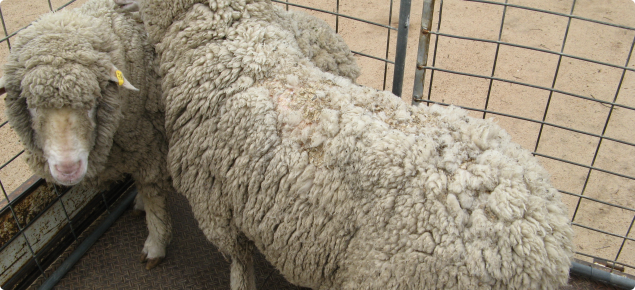Early reporting of diseases supports market access
Producers play a vital role in the early detection of exotic diseases in Australia. Reporting diseases early means they can be controlled and eradicated more easily. If you see unusual disease signs, abnormal behaviour or unexpected deaths in your stock, ring your local veterinarian, Department of Primary Industries and Regional Development (DPIRD) veterinary officer or the Emergency Animal Disease hotline on 1800 675 888.
Photosensitisation of sheep can resemble the exotic diseases foot-and-mouth disease, bluetongue and sheep pox.
What is photosensitisation?
Photosensitisation is inflammation of the skin, and occasionally conjunctiva and cornea of the eye. Sunlight activates photosensitising substances in these tissues, resulting in local damage. It differs from sunburn in that photosensitisation does not require prolonged exposure to sunlight to develop.
Which animals are most at risk?
All livestock types, breeds and classes can be affected by photosensitisation, but it is less likely to occur in pigmented skin, or skin with a long covering of hair or wool. For this reason, photosensitisation is more likely to be seen in livestock with unpigmented or white skin.
Signs of photosensitisation
The signs of photosensitisation include:
- severe irritation, restlessness, rubbing and shaking of head and ears
- seeking shade
- swelling of affected areas including ears, eyelids, lips and nose. Swelling around the lips and nose may cause difficulty with eating and breathing. Swollen ears droop and may be a distinctive feature
- discharge from the eyes, conjunctivitis, corneal opacity
- sometimes lameness (photosensitisation affecting the coronary band)
- dead and sloughing skin in the affected areas, with underlying tissues becoming inflamed and scabs forming over the inflammation. This is often first noticed at the tips of the ears, but can extend to the whole face, unpigmented areas of the body, and areas of bare skin like the udder, teats, vulva and upper surface of the tail. The tip and underside of the tongue may be affected, as these can be exposed to sunlight when the animal licks its affected lips and muzzle
- jaundice (yellowing of skin, gums and whites of the eyes) may be noticed in cases of secondary photosensitisation.
Secondary photosensitisation sometimes occurs in livestock grazing:
- lupins colonised with Diaporthe toxica (Phomopsis sp.), leading to lupinosis
- Paterson’s curse (Echium plantagineum)
- heliotrope (Heliotropium europaeum)
- ragwort (Senecio jacobaea) (very restricted distribution in WA).
It may also occur when stock are poisoned by toxic blue-green algae.
Photosensitisation also occasionally occurs spontaneously on some pastures and crops, including biserrula, medics, clovers, oats, barley, wheat, lucerne, canola, and even capeweed. The photosensitising substances or the toxins involved in these occurrences are not known, and in most there is no clear evidence as to whether they are primary or secondary photosensitisation. However, with biserrula there is strong evidence that the photosensitisation is primary.
What causes photosensitisation?
When photosensitising substances accumulate in the bloodstream, they may be exposed to sunlight when passing through capillaries close to the surface of the skin, conjunctiva, cornea and other visible mucous membranes. They are activated by the sunlight and cause local tissue damage and inflammation. Accumulation of photosensitising substances can be a primary or secondary process.
Primary photosensitisation
Primary photosensitisation results from eating (or absorbing through the skin) a photosensitising substance that is not modified in the body. It is associated with livestock grazing:
- St John’s wort (Hypericum perforatum; contains the photosensitising substance hypericin)
- Queen Anne’s lace (Ammi majus; contains furanocoumarins)
- buckwheat (Fagopyrum esculentum; contains fagopyrin)
- parsley (Petroselinum crispum; contains furanocoumarins).
These plants all have a restricted distribution in WA. To check if these plants are present in your area, go to the Department of Biodiversity and Conservation website.
Secondary photosensitisation
Secondary photosensitisation is the most common form of this disease in Australia. It occurs following liver damage from consuming plant toxins. In all cases the photosensitising compound is phylloerythrin, produced in the breakdown of chlorophyll in the gastrointestinal tract. Normally, phylloerythrin is absorbed into the blood, then removed by the liver and excreted in the bile. When there is liver damage, this process is disrupted, leading to accumulation of phylloerythrin in the blood and subsequent photosensitisation.
Secondary photosensitisation is most commonly associated with livestock grazing:
- caltrop (Tribulus terrestris)
- Brachiaria spp., including signal grass
- Panicum spp., including some millets
- ryegrass pastures heavily contaminated with the spores of Pithomyces chartarum, leading to facial eczema
- rough dog’s tail (Cynosurus echinatus), leading to acute bovine liver disease
- lantana (Lantana camara) (only a garden plant in WA).

